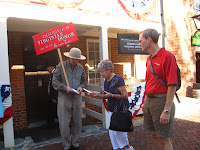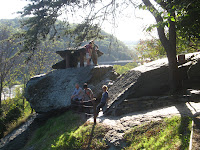Nestled at the confluence of the Shenandoah and Potomac rivers is the historic town of Harpers Ferry, WV. , and the Harpers Ferry National Historic Park.
Until Civil War times, West Virginia was a part of Virginia. Harpers Ferry has a long association with history-makers of the United States. George Washington was well-acquainted with the area as a surveyor. Later, as president of the Patowmack Company (which was formed to complete river improvements on the Potomac and its tributaries), he traveled to Harpers Ferry during the summer of 1785 to determine the need for bypass canals. In 1794 Washington's familiarity with the area led him to propose the site for a new United States armory and arsenal.
Thomas Jefferson stopped there in October, 1783, on his way to Philadelphia to serve as a delegate to the Continental Congress. From a rock high above the rivers, Jefferson declared "the passage of the Potomac though the Blue Ridge to be perhaps one of the most stupendous scenes in nature.” See a picture of Jefferson's rock and the view below.
In March, 1803, Washington's armory supplied Meriwether Lewis with items he would soon need on the transcontinental expedition with William Clark.
56 years later, Harpers Ferry would become the flash point for a looming civil war. Firey abolitionist John Brown believed he could free some slaves and start a slave uprising against the slave-holding southern states. He selected Harpers Ferry as his starting point. Determined to seize the 100,000 weapons at the Arsenal and to use the Blue Ridge Mountains for guerrilla warfare, abolitionist Brown launched his raid on October 16, 1859. His 21-man "army of liberation" seized the Armory and several other strategic points. Thirty-six hours after the raid begun, with most of his men killed or wounded, Brown was captured in the Armory fire engine house (now known as "John Brown's Fort") when U.S. Marines stormed the building.
Brought to trial at nearby Charles Town, Brown was found guilty of treason, of conspiring with slaves to rebel, and murder. He was hanged on December 2, 1859. John Brown's short-lived raid failed, but his trial and execution focused the nation's attention on the moral issue of slavery and headed the country toward civil war.
The town has been preserved and many original buildings still exist.
On the day we visited (October 9), they were re-enacting the election of 1860, with full costumes and political speeches.
Did you know that Abraham Lincoln was not on the ballot in Virginia in 1860? Anyone voting for him would have been considered a traitor to Virginia.
One of the buildings housed a museum describing John Brown's raid on the armory. Below are some of the signs from the museum, and the firehouse, known as John Brown's fort, was restored on the site.
Built in 1833, St Peter's Catholic Church sits on a prominent high point above town.
Even higher above town is Jefferson's rock, mentioned earlier, which gives a beautiful view of the town and the rivers.
Some of the descriptions above were taken from Wikipedia. To read more about Harpers Ferry, click here.
It was a great day, and all three of us really enjoyed it. There was more to see than the time we had available. Barb and I hope to go back again someday to see more.


























1 comment:
i love the re-enactments! That would be so cool to see.
Post a Comment